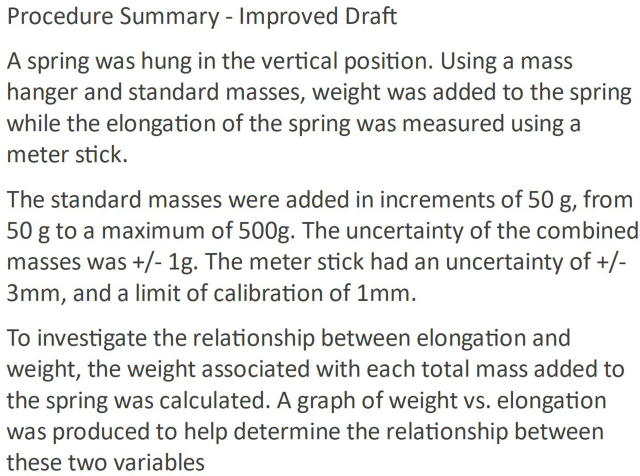Inquiry Reports at the AP Level
Lab Objectives for AP Physics C
Students will be able to
- Design experiments: Describe the purpose of an experiment, identify common lab equipment and describe its use, draw helpful diagrams, describe procedures to be used, including controls and measurements.
- Observe and measure real phenomena: Make relevant observations with a variety of instruments.
- Analyze data: Display graphs and tables, fit lines and curves, perform calculations, make extrapolations and interpolations.
- Analyze errors: Identify sources of error and how they propagate, estimate magnitude and direction of errors, determine significant digits, identify ways to reduce error.
- Communicate results: Draw inferences and conclusions, suggest ways to improve an experiment, propose questions for further study.
Science Practices for AP Physics 1 and 2
The student can
- Use representations and models to communicate scientific phenomena and solve scientific problems, including creation, description, refinement, use, and re-expression of models.
- Use mathematics appropriately, including justification and application of mathematical routines, as well as estimation of numerical quantities.
- Engage in scientific questioning to extend thinking or to guide investigations, including posing, refining, and evaluating scientific questions.
- Plan and implement data collection strategies in relation to a particular scientific question, including justification of the kind of data selected, planning a design, collecting data, and evaluating sources of data.
- Perform data analysis and evaluation of evidence, including refining observations and measurements, and evaluating the evidence provided by data.
- Work with scientific explanations and theories, including justification of claims with evidence, constructing explanations based on evidence, articulation of the reasons that scientific explanations are refined or replaced, making claims and predictions about natural phenomena, and evaluation of alternative scientific explanations.
- The student is able to connect and relate knowledge across various scales, concepts, and representations in and across domains, including the connection of phenomena and models across spatial and temporal scales, and the connection of concepts in and across domains.
Common Threads
Inquiry is not the same thing as discovery. Students operate with full knowledge of physics formulas, laws, explanations, and theories. The inquiry process may be summarized as follows:
Student should be able to
- Pick the correct formula for the scenario and anticipate an outcome based on the formula
- Write a hypothesis
- Design an experiment to test the hypothesis
- Perform a numerical or graphical analysis
- Evaluate the analysis results (confirm, refute, inconclusive) based on evidence
In addition, the general vocabulary developed for AP Physics 1 and 2 around scientific models and experimental design is suitable for AP Physics C as well.
Inquiry Report Checklist
Introduction
- Includes the question or problem being investigated
- Defines relevant vocabulary
- Provides relevant background information including one or more well-established equations
Hypothesis
- Consistent with the information in the introduction
- Written as if were a true statement
...Provisional until the outcome of the inquiry is known, however, write the hypothesis as if it were already confirmed. - Describes a specific, testable outcome of the inquiry, often a relationship between variables
Procedure
- Past tense, passive voice
- Narrative form rather than a numbered list
- Relevant detail only, concisely stated
- Variables (independent and dependent) and controls identified
- Measuring devices with uncertainty and/or limit of calibration identified
- Analysis method described (but not the outcome of the analysis)
Data
- Starts with a sentence or two introducing and explaining the contents of the data table
- Units listed in the column headings
Analysis
- Starts with a sentence or two describing any graphs and or calculations being presented
- Includes all relevant graphs and calculations necessary to determine the relationships revealed by the data
Dependent variable is usually plotted on the y-axis, independent variable on the x-axis. - States the actual relationships determined during the experiment
On the graph, the equation is given by graphing software in terms of x and y. Your statement of the equation should replace x and y with the actual variables measured.
This page lists the steps in performing a graphical analysis, with an example.
Conclusion
- Includes a discussion of the validity of your hypothesis (confirm, refute, or
Be sure to cite specific data from your experiment that confirms or refutes your hypothesis, or fails to allow you to reach a clear judgment - Includes a comparison of any experimental results to the known correct values
Typically, this will require you to compare the equation you determined from your graphs to the known equation we have learned in class. - Describes scatter around a line of best fit or from an accepted value and relates such scatter to factors not included in your model and to sources of error
Examples:
"Friction was assumed to be constant but might actually have varied."
"The object on the spring was moving slightly as its position was measured, increasing the uncertainty." - Discusses the influence of error on your confidence in the results and ways to improve the procedure or the model being used
Sample Procedure

